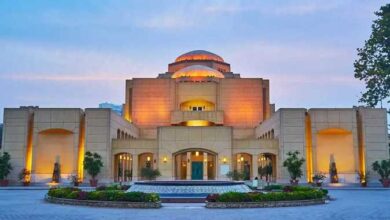In the crammed cube that is El Mastaba Center for Egyptian Folk Music’s Tanboura Hall, audience and performers were forced to mingle last Thursday, both because of their physical proximity and because of the infectious beats of the band Rango, whose music filled the small space.
Even though the rango–a traditional African wooden xylophone–is marketed as the focal point of the band’s music, it plays more of a symbolic role rather than an essential one. Rango, the band, was formed by the director of El Mastaba, Zakaria Ibrahim, with the aim of reviving Southern folk songs and music and the bulk of their set did not feature the instrument.
“The band’s music is a mixture of Sudanese, Nubian and Egyptian folk songs and Zar music,” Ibrahim said. Rango took this hodgepodge of musical traditions and made their performance a variety of songs, rather than a fusion of music. The participatory atmosphere gives an acute sense of the environment the band is coming from and what, exactly, it is trying to revive and remember.
The history of the Sudanese in Egypt is a complicated one. During Mohamed Ali Pasha’s reign, Egypt conquered Sudan and imported many soldiers to serve in the Egyptian army. Slaves were also brought in from Sudan to work in the cotton fields. Both the soldiers and slaves brought their music and traditions with them.
As they settled into neighborhoods in Cairo and elsewhere around Egypt, they tended to group themselves with Southern Egyptians and Nubians. “A musical exchange happened in these areas everyday, and that is what we’re trying to recreate,” Ibrahim said. El Mastaba’s goal is to revive folk music in its original context first–the very localized ghettos–then to the rest of Egypt, and eventually the world.
The music is played with traditional instruments: the simsimiyya, tanboura, duff, tabla, bongos and, of course, the rango. Despite the rango featuring in only a few songs at the end of Rango’s set to a marginal musical effect, its unveiling from beneath a sheet is presented as a seminal moment in the performance.
Tito, the band’s main mascot and one of their many tabla players and singers, performs the unveiling–for what must seem to him like the millionth time–with exaggerated gravity and feigned awe. Hassan Bergamon, another band member, puts down his simsimiyya and takes his place behind the title instrument.
“Bergamon is the last remaining rango player in Egypt, and this rango is the last surviving one in Egypt. To find it we had to ask the descendants of the past masters,” Zakaria explained. When Zakaria put the band together in 1996, he knew that the rango’s unveiling would represent the process of folkoric revivification. It’s presence on stage, though aesthetically unspectacular, adds credence to Tanboura hall’s role in reviving waning art forms.
The music, which encourages audience participation, is eclectic enough to move different listeners at different times in different ways. Rango members seem to thrive on the various styles of the participating audience members; they were also prone to random gyrations during their performance.
It seems like Rango’s ultimate goal would be to get rid of the seats entirely and provide an entirely participatory concert from beginning to end. “Our music depends on the audience being with us. It is true that a lot of the music is originally Zar music (used in exorcisms), but a lot of it also has to do with shared spirituality and getting together through difficult times. Don’t forget, a lot of these songs came through slaves on the cotton fields,” said Hassan Vikka, a tabla player and singer.
Many of the songs represent a collective attempt to get through hard times, through melodic tales of the homeland, as well as slapstick descriptions of commanding officers.
Ibrahim said he wishes to continue working for the exclusive purpose of reviving Egyptian folklore. “I’ve been dedicated to this since 1988, and the center’s goal is to help folklore grow and develop, first and foremost in the neighborhoods from which they came.”




